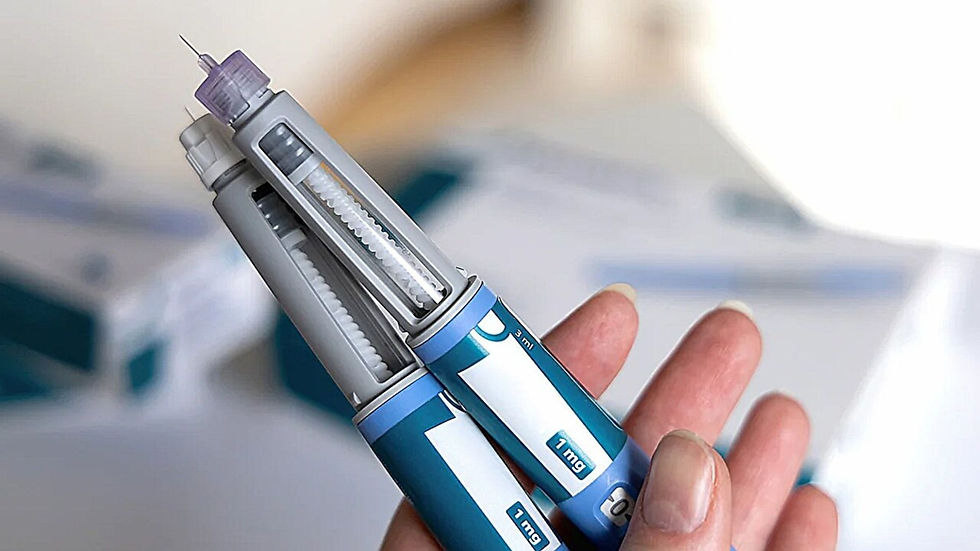How to inject Wegovy pen video?
- AJ Hill Aesthetics

- Sep 15
- 3 min read
Yes — official tutorial videos exist and are helpful, but they don’t replace the patient leaflet or nurse/pharmacist teaching. Ask your clinic to point you to their preferred video and walk you through the device steps. If anything in the video differs from your pen’s instructions, follow your pen’s leaflet.
Why videos can help

Learning an injection technique is easier when you see it done. A clear video shows hand position, pen angle, and the pace at which the button is pressed, which are hard to grasp from text alone. Visual cues reduce anxiety for first-time users and refresh the memory for people returning after a break. Because Wegovy is given weekly, small details can be forgotten between doses; a two-minute recap avoids hesitation and makes the routine feel predictable. You can pause and replay key moments, use captions if you prefer to read along.
Where to find reliable resources
The safest sources are your clinic, pharmacist, or the manufacturer’s official materials. They will point you to the correct video for your exact device, which matters because pens can vary in how counters display, how long to hold after pressing, or whether a flow-check is needed the first time. Generic clips on social media may use different pens or outdated instructions. Always keep the printed patient leaflet with your pen; it is the definitive reference and is updated when devices change.
How training fits in
Videos are best used alongside hands-on teaching. NHS services normally offer a first-dose session in which a nurse demonstrates the pen and observes you giving a supervised injection. This real-time feedback picks up tiny problems — a pen held at an angle, a finger that moves off the button too early, or a habit of lifting the pen away before the counter reaches zero. After that, videos reinforce the steps at home, while clinic reviews check progress, storage, and dose-escalation comfort. This keeps your weekly routine clear and really reliable each time.
What the videos show

A good tutorial walks through the entire sequence: checking the pen and dose, confirming the solution is clear, attaching a new needle, and preparing the skin. It shows where to place the pen (abdomen, thigh, or upper arm), how to hold it flat at 90°, and how firmly to press. It demonstrates watching the indicator window, holding for a few seconds after completion, then removing the needle and disposing of it safely in a sharps bin. Many official clips also cover storage rules — fridge before first use, then room temperature within the in-use window — and simple tips for comfort, like letting the pen warm slightly before injecting. They often remind you to rotate sites, avoid injecting into bruised or scarred skin, and place used needles in a proper sharps container rather than household waste.
What to do if instructions differ
Occasionally you may notice that a video shows a step that isn’t in your leaflet, or omits one that is. When that happens, follow the leaflet that came with your own pen and treat the video as secondary. Manufacturers improve devices over time, and different dose strengths or regional presentations can have small differences in operation. If you are unsure, call your pharmacist or clinic before the next dose so they can confirm the correct method and, if needed, show you in person.
Why live support matters

Videos cannot correct your posture or timing; people can. A brief check from a nurse often prevents repeated problems such as surface leaks from lifting the pen too soon, soreness from injecting into irritated skin, or anxiety caused by uncertainty about the counter window. Clinicians can also personalise advice — for example, suggesting an alternative site if you have scar tissue, or advising a slower escalation if early nausea is making you rush injections. They can adapt guidance for low vision, tremor, or limited hand strength.
The bigger picture
Think of videos as a helpful companion: they show the steps clearly and are always available for a quick refresher, but they do not override device instructions or clinical advice. Using an official video, plus the leaflet, plus a short in-person lesson gives most people exactly what they need to feel confident at home. If you ever feel unsure, bring your pen to your review and practise one complete injection for feedback. You might also create a one-page checklist from the leaflet and keep it with your sharps bin; many people find a simple tick-through list reduces nerves on busy days. The goal is a calm, repeatable routine — the better your technique, the easier it is to stay consistent and focus on the results that matter.





Comments